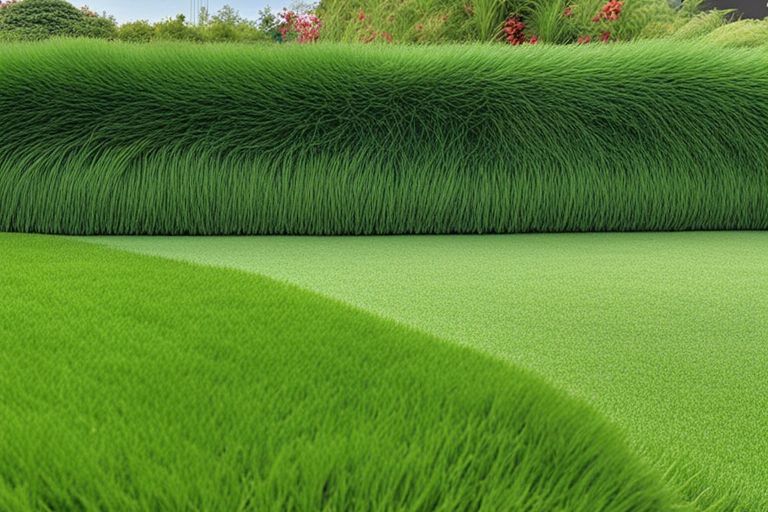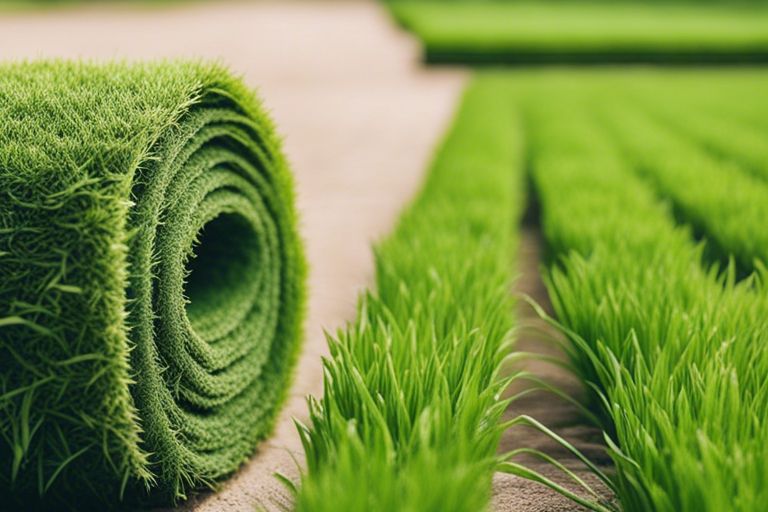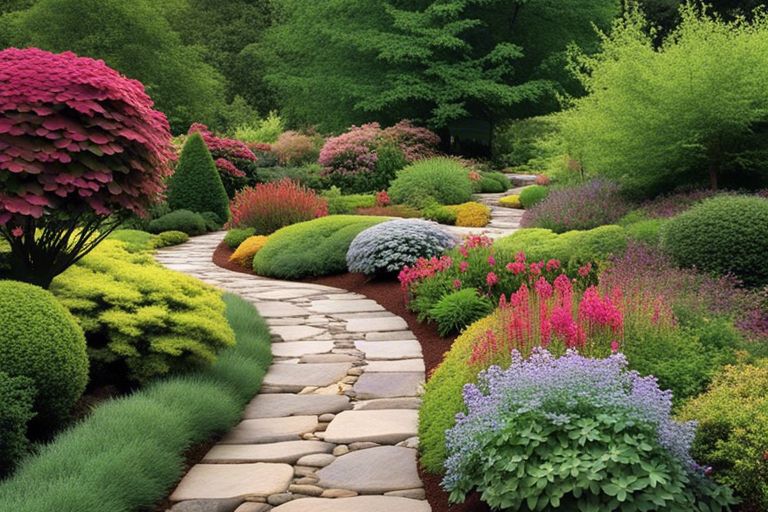Many gardeners and landscape enthusiasts are increasingly leaning toward grass in a landscaper’s roll as a sustainable landscaping choice. By choosing this option, you not only enhance the aesthetic appeal of your space but also contribute to a healthier ecosystem that supports local biodiversity. This type of grass, often specifically cultivated for sustainability, helps mitigate soil erosion, improves air quality, and uses less water than traditional landscaping methods. In this post, you will explore the benefits and practices that make this green choice an environmental win for your yard and community.
Key Takeaways:
- Environmental Benefits: Grass in a landscaper’s roll contributes to soil health and reduces erosion, promoting a sustainable ecosystem.
- Water Efficiency: Many varieties of rolled grass are drought-resistant, requiring less water compared to traditional lawns.
- Quick Installation: Using a rolled grass option allows for immediate coverage and results, reducing the need for ongoing maintenance and resources.

Environmental Benefits
Your choice of grass in a landscaper’s roll is not only an aesthetic enhancement but also a sustainable option that can significantly contribute to the health of our planet. By understanding the environmental benefits, you can appreciate how this element of landscaping plays a crucial role in promoting ecological balance. From carbon sequestration to air quality improvement, the advantages of grass extend far beyond your garden; they resonate deeply within the ecosystem.
Carbon Sequestration
With the rising concerns about climate change, carbon sequestration emerges as a vital factor in sustainable landscaping. Grass acts as a natural sponge for carbon dioxide, one of the primary greenhouse gases responsible for global warming. As you cultivate grass in your landscape, it absorbs CO2 from the atmosphere and stores it in the soil. This process not only helps in mitigating climate change but also promotes healthier soil structures, fostering biodiversity beneath your feet.
Moreover, the incorporation of diverse grass species can enhance this carbon sequestration process. When you choose a variety of grasses in your landscaping roll, you’re enabling a more resilient ecosystem capable of capturing even more carbon over time. Each blade of grass plays its part in the intricate web of life, a gentle reminder that every little effort adds up in the quest for sustainability.
Soil Erosion Prevention
For those looking to create a stable environment, preventing soil erosion is paramount. Grass plays a critical role in anchoring the soil with its deep-root systems. By planting grass in your yard, you help to hold the soil in place, reducing runoff during storms and preventing the loss of precious topsoil. This is particularly imperative in areas prone to heavy rains, where unprotected soil can be easily washed away, leading to detrimental effects on local ecosystems.
Plus, healthy grass doesn’t just hold your soil in place; it also encourages water infiltration. This means that instead of flowing away and causing erosion, rainwater seeps into the ground, which allows for better moisture retention. In turn, this process supports plant life, facilitates strong root development, and contributes to overall soil health, creating a self-sustaining environment right in your own backyard.
Air Quality Improvement
On a broader scale, grass lawns provide significant benefits to air quality. They have the remarkable ability to filter dust, dirt, and harmful pollutants from the air, capturing particles that can otherwise cause respiratory issues for you and your family. Furthermore, as grass grows, it contributes oxygen back into the atmosphere—a process that is vital for life. The more grass you incorporate into your landscape, the more you’re actively participating in the creation of cleaner air.
Benefits don’t just stop at air filtration; grass also plays an imperative role in climate regulation. Through the process of photosynthesis, grasses help to lower temperatures in urban areas, creating a cool and inviting environment. This is particularly important as urban sprawl continues to grow, leading to adverse effects like the heat island phenomenon. By nurturing grass in your landscape, you are contributing to a cooler, healthier, and more breathable tomorrow for everyone.
Water Conservation
Even in the pursuit of a vibrant and lush landscape, water conservation must be a top priority. You may not realize it, but your choice of grass from a landscaper’s roll can significantly contribute to sustainable landscaping practices. By selecting grass varieties that require less water, you can greatly improve the efficiency of your irrigation practices while still maintaining a beautiful yard. For detailed insights, you can explore Sustainable Landscape Conversion: Design and Irrigation, which emphasizes the connection between landscape design and effective water usage.
Reduced Irrigation Needs
On selecting grass that thrives in local conditions, you can ensure reduced irrigation needs. These hardy grasses have adapted to their environments and require less frequent watering compared to traditional varieties. By employing native or drought-resistant grasses in your landscape, you lessen the demand on your irrigation system while maximizing your yard’s resilience against dry spells. This not only conserves water, but it also minimizes your utility bills and maintenance efforts.
Efficient Water Absorption
Water efficiency goes beyond just reduced irrigation. Water absorption is another important factor to consider. Grass varieties that possess deep and extensive root systems allow rainwater to penetrate deeper into the soil. This supports the grass by enhancing its access to moisture, which decreases the need for supplementary watering from your sprinkler or hose.
The ability of grass to absorb water efficiently stabilizes the soil and reduces evaporation, leaving you with a more sustainable landscape. As you cultivate a more water-efficient yard, you foster a healthier ecosystem, encouraging diverse plant life that benefits the entire environment.
Minimized Stormwater Runoff
Irrigation practices that incorporate grass from a landscaper’s roll can also help minimize stormwater runoff. When rain falls on your landscape, grass allows water to infiltrate the soil rather than wash away unused, leading to reduced erosion and pollution of local waterways. This natural filtration is crucial, especially in urban areas where hard, impervious surfaces often lead to larger runoff challenges.
Another benefit arises from the ability of grass to function as a green sponge. By absorbing rainwater efficiently, it mitigates the overwhelming deluge that results from heavy storms, providing relief to drainage systems and ultimately protecting aquatic ecosystems.
Biodiversity and Ecosystems
Many individuals overlook the role of grasslands in fostering biodiversity and sustaining ecosystems. When you embrace landscaping solutions that include grass in a landscaper’s roll, you actively contribute to creating a thriving habitat not just for plants, but for a myriad of wildlife. A healthy lawn serves as the foundation for various species, promoting a balanced ecosystem that supports everything from beneficial insects to larger wildlife. By choosing sustainable landscaping practices, you engage in a great initiative that resonates with the principles of environmental stewardship and ecological harmony.
Habitat Creation for Wildlife
With every square foot of grass that you install, you are effectively creating vital habitats for numerous species. Grasslands provide necessary shelter and foraging grounds for small mammals, insects, and even birds. By allowing grasses to flourish, you ensure that these creatures have the resources they need to thrive. Furthermore, sustainable grasslands support soil health and water quality, making them a critical component of the larger environment. When you think about the health of your landscape, don’t forget its importance to wildlife—a dynamic relationship exists between the health of your lawn and the well-being of local ecosystems.
Native Plant Species Preservation
Ecosystems are often strained due to the introduction of non-native plant species that overshadow local flora. By prioritizing grass blends that include native species, you play a vital role in preserving unique plant life that is well-suited to your specific region’s climate and soil conditions. Native species often require less water and fewer chemical inputs, leading to a more sustainable landscape overall. Furthermore, these plants have adapted over time to create the intricate relationships necessary for healthy ecosystems, leading to enhanced soil stabilization and riparian zone resilience.
Plus, by preserving native plant species, you help ensure that local wildlife retains its food sources and habitats. You are cultivating a resilient landscape that stands strong against environmental changes and pressures, like drought or invasive species. This conscious choice has rippling effects: when you support native plants, you also support the insects and animals that depend on them, thereby ensuring a balanced ecosystem.
Pollinator-Friendly Environments
Wildlife thrives in environments that support pollinators, which are critical to the longevity of both landscapes and food systems. By incorporating grasslands and native flowering plants into your landscaping choices, you create a safe haven for bees, butterflies, and other important pollinators. These creatures are necessary for the reproduction of many plants, helping to maintain biodiversity while ensuring the health of our crops. You are not simply cultivating an aesthetic environment; you are engaging in a restorative practice that strengthens the connection between plants and animals.
Understanding the significance of pollinator-friendly environments allows you to appreciate the larger role your landscaping choices play in ecological health. By being intentional about creating spaces that support these vital insects, you transform your lawn into a sanctuary, allowing biodiversity to flourish. The profound impacts of your landscaping choices reach far beyond your property lines, contributing to a greater ecosystem that enriches both your environment and the lives of countless species. Your actions today ripple through time, promoting a sustainable future for all living beings.
Social Benefits
Keep in mind that choosing grass in a landscaper’s roll not only contributes to the ecological aspects of sustainability but also brings numerous social benefits to your community. The lush greenery that rolls out across your property can serve as a gathering spot, fostering connections among neighbors and creating a sense of belonging. With the right landscaping, you can establish outdoor spaces that encourage social interactions, nurturing bonds that are often overlooked in our fast-paced lives.
Community Engagement Opportunities
Community engagement is an vital element of healthy neighborhoods. By transforming your landscape with quality grass, you set a precedent that encourages others to do the same. A well-maintained yard serves as an attractive invitation for neighbors to converse, share ideas, and collaborate on local projects. This not only enhances the beauty of your area but also strengthens community ties that can become vital in times of need.
Aesthetic Appeal and Property Value
For homeowners, the aesthetic appeal of your landscape can have a direct impact on property value. The presence of lush, green grass creates a visual harmony that invites admiration and appreciation from both visitors and potential buyers alike. An attractive yard is often one of the first impressions that a home provides, leading to an increase in marketability and overall home value. When others see your investment in a vibrant landscape, they’re more likely to recognize the value of their own homes as well.
Engagement with your surroundings is vital to creating a cohesive and attractive community. High-quality grass not only uplifts the immediate environment but acts as a catalyst for others to adopt similar practices, which fosters a neighborhood of pride and beauty. The ripple effect of your sustainable choice can extend to influence others, inspiring a wave of enhancement that enriches the entire community landscape.
Mental Health and Well-being
Health experts have long recognized that access to green spaces can profoundly influence your mental well-being. By incorporating grass into your landscape, you are granting yourself a personal oasis where you can unwind and recharge. The natural setting facilitates relaxation and encourages outdoor activities that can elevate your mood and mitigate stress. The calming effect of the color green and the scent of grass intertwine, forming a sanctuary that nurtures both your mental health and physical fitness.
Engagement with nature, even in your own backyard, plays a crucial role in developing a positive mindset. Studies show that individuals living near green spaces report lower levels of anxiety, and higher levels of happiness. As you cultivate your grassy landscape, you’ll find that your overall well-being can blossom alongside it, creating a healthy home and community environment.
Property ownership isn’t just about maintaining an asset; it’s about enhancing community life. With the **right landscaping** choices, you’ll find that your home becomes a **hub of activity and joy**, creating spaces where both you and your neighbors can thrive. Embrace your commitment to sustainability—your effort will yield not only aesthetic beauty but also lasting social benefits.
Economic Advantages
To understand the economic advantages of using grass in a landscaper’s roll for your sustainable landscaping projects, one must first recognize the multifaceted benefits that this choice brings to the table. Not only does it offer a touch of nature to your surroundings, but it also presents an opportunity to save significantly in the long run. You’ll discover that the integration of this grass can lead to a decrease in your landscaping expenses, making it a cost-effective solution for transforming your outdoor spaces.
Cost-Effective Landscaping Solution
Solution-focused landscaping means selecting options that provide the greatest returns for your investment. By opting for rolled grass, you eliminate the uncertainties associated with seeding and growing your lawn from scratch. The establishment time is greatly reduced, meaning you can enjoy your lush greenery much sooner. Furthermore, a well-established grass roll is less susceptible to weeds and disease, reducing the need for expensive treatments and interventions.
Reduced Maintenance and Upkeep
On the maintenance front, using grass in a landscaper’s roll can drastically simplify your lawn care routine. Once installed, this sod requires significantly less watering, mowing, and fertilization than traditional lawns, translating to lower water bills and decreased labor efforts. The initial investment pays off as you spend less time and money on upkeep, allowing you to channel your energy into enjoying your outdoor space rather than constantly tending to it.
Economic savings are amplified by the fact that a healthy, established grass lawn can better resist pests and diseases, ultimately requiring minimal intervention and support. By avoiding the common pitfalls of traditional lawn establishment, you ensure that your time and resources are preserved.
Increased Property Value
Landscaping with quality, sustainable grass not only enhances the aesthetic appeal of your property but can also lead to an increase in property value. Many homebuyers look for well-landscaped yards as a sign of care and maintenance, making your investment a strategic move for the future. A verdant, thriving lawn contributes to a welcoming atmosphere, which can be a significant selling point when the time comes to relinquish your property.
Maintenance of your landscape translates directly into the perceived value of your home. A well-kept environment not only attracts attention but also fosters a sense of pride in your ownership. When buyers see a lush, green lawn crafted from high-quality grass, they are often willing to invest more, knowing that it reflects the integrity of the property as a whole.
Implementation and Maintenance
Now that you have chosen grass in a landscaper’s roll as a sustainable landscaping option, it’s crucial to understand how to implement and maintain it effectively. This process begins with applying proper installation techniques, ensuring that the grass takes root and thrives in its new environment.
Proper Installation Techniques
For optimal results, you should prepare the soil by removing any existing plants and debris, and then leveling it to create a smooth surface. Ensure that the soil is well-aerated by tilling, allowing for proper drainage and root penetration. When rolling out your grass, be mindful of overlapping seams, as this can create uneven patches. Following the installation, water the area generously but avoid saturating it, which can lead to soggy soil that suffocates roots.
For best results, consider laying your grass during the cooler months or early fall, which helps reduce stress on the newly installed landscaping. Additionally, you can walk on the grass minimally during the first few weeks, allowing it to establish itself. Early attention to these details will make your transition to a sustainable landscape smoother.
Regular Mowing and Care
Regular maintenance is crucial in keeping your installed grass vibrant and healthy over time. Establish a mowing schedule, and try to cut your grass to a height of three to four inches to promote strong root growth and reduce competition with weeds. It’s also crucial to keep your mower blades sharp; dull blades tear the grass rather than cut it cleanly, making it susceptible to disease.
Care for your lawn also involves proper watering techniques. Implement deep watering practices to encourage deeper root growth, allowing your grass to withstand periods of drought. It’s important to adjust watering schedules based on weather conditions; for instance, reduce watering during rainy periods to prevent over-saturation, which can be damaging to the grass.
Integrated Pest Management Strategies
Implementation of Integrated Pest Management (IPM) strategies will help you address any potential pest issues in a sustainable manner. Start by regularly monitoring your grass for signs of pests or disease, keeping an eye out for any unusual discoloration. When issues arise, identify the specific pest before taking action. This will help you choose the most effective control methods, whether that’s selecting plants that attract beneficial insects or using organic pest repellents.
This proactive approach also involves creating an environment that discourages pests while promoting healthy grass growth. Incorporating beneficial organisms into your soil can balance pests naturally. Additionally, fostering biodiversity in your landscape by planting different types of flowers and shrubs around your grass can enhance your yard’s resilience against pests.
Summing up
As a reminder, choosing grass in a landscaper’s roll as a sustainable landscaping option is more than simply an aesthetic choice; it embodies a responsibility towards the environment. By selecting high-quality rolls of grass, you are investing in a solution that promotes biodiversity, supports local ecosystems, and reduces water usage compared to traditional seeding methods. The ease of installation and the immediate gratification of a lush, green lawn means your outdoor spaces can be both beautiful and environmentally friendly, allowing you to connect with nature in a more profound way.
Furthermore, the use of these rolls often leads to a decrease in soil erosion and an increase in carbon sequestration, making your landscaping efforts not just a personal endeavor, but a contribution to the greater good of your community. As you cultivate your green spaces, remember that each blade of grass represents an opportunity to foster a sustainable relationship with the land. By making thoughtful choices about your landscaping options, you not only enhance your surroundings but also honor the delicate balance of nature that sustains us all.
Q: What are the environmental benefits of using grass in a landscaper’s roll?
A: Grass in a landscaper’s roll provides numerous environmental benefits. It plays a crucial role in soil preservation by reducing erosion, enhancing soil health, and increasing its capacity to hold water. Additionally, grass acts as a natural filter, improving air quality by absorbing carbon dioxide and releasing oxygen. It helps to mitigate urban heat by cooling the surrounding areas, thereby reducing the need for artificial cooling in nearby buildings. Furthermore, grass provides habitat for various wildlife, supporting biodiversity in both urban and rural landscapes.
Q: How does using grass in a landscaper’s roll contribute to water conservation?
A: Grass in a landscaper’s roll is particularly beneficial for water conservation. Establishing a grassy area can help absorb rainwater and minimize runoff, allowing water to percolate into the ground, which replenishes groundwater supplies. Some types of grass are drought-resistant, requiring less irrigation once established, thereby conserving water resources. Moreover, grasses can help maintain moisture in the soil, reducing the need for frequent watering and enabling sustainable landscaping practices that are mindful of local water availability.
Q: What makes grass in a landscaper’s roll a low-maintenance landscaping option?
A: Grass in a landscaper’s roll is considered a low-maintenance landscaping choice due to its ease of establishment and resilience. Once laid, it quickly roots into the existing soil, promoting fast growth and coverage. Many grass types used in landscaper rolls are bred for durability and adaptability to local climates, which reduces the need for extensive care. Regular mowing, occasional fertilization, and irrigation—especially during establishment—are the primary maintenance tasks. This low-maintenance characteristic makes it a practical option for homeowners and property managers looking for sustainable yet manageable landscapes.



